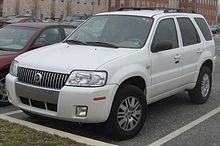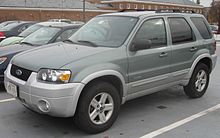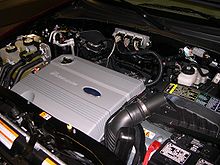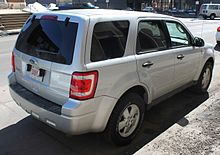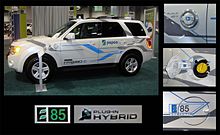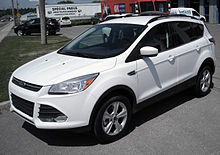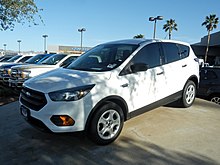Ford Escape
|
|
It has been suggested that Mazda Tribute be merged into this article. (Discuss) Proposed since November 2017.
|
| Ford Escape | |
|---|---|
_Ambiente_wagon_(2017-11-18)_01.jpg) |
|
| Overview | |
| Manufacturer | Ford |
| Production | 2000–present |
| Model years | 2001–present |
| Body and chassis | |
| Class | Compact crossover CUV |
The Ford Escape is a compact crossover vehicle sold by Ford since 2000 over three generations. Ford released the original model in 2000 for the 2001 model year—a model jointly developed and released with Mazda of Japan—who took a lead in the engineering of the two models and sold their version as the Mazda Tribute. Although the Escape and Tribute share the same underpinnings constructed from the Ford CD2 platform (based on Mazda GF underpinnings), the only panels common to the two vehicles are the roof and floor pressings. Powertrains were supplied by Mazda with respect to the base inline-four engine, with Ford providing the optional V6. At first, the twinned models were assembled by Ford in the US for North American consumption, with Mazda in Japan supplying cars for other markets. This followed a long history of Mazda-derived Fords, starting with the Ford Courier in the 1970s. Ford also sold the first generation Escape in Europe and China as the Ford Maverick, replacing the previous Nissan-sourced model. Then in 2004, for the 2005 model year, Ford's luxury Mercury division released a rebadged version called the Mercury Mariner, sold mainly in North America. The first iteration Escape remains notable as the first SUV to offer a hybrid drivetrain option, released in 2004 for the 2005 model year to North American markets only.
Mainstream production of the first generation Escape/Tribute ended in late 2006. For Asia-Pacific markets, both received respective facelifts in 2006 and had production fully transferred to Ford Lio Ho in Taiwan. Extended production of the Mazda lasted until 2010, with the Ford lingering on until 2012.
Second generations of the Ford Escape, Mercury Mariner, and Mazda Tribute were released in 2007 for the 2008 model year, but mostly restricted to North America. In other markets, the first generation models were either replaced by updated first series versions built in Taiwan, and/or by the unrelated Mazda CX-7 (2006) and Ford Kuga (2008). The North American second generations were merely reskins of the first, with carry-over mechanicals, but with restyled hanging panels and a redesigned interior. Unlike the collaborative approach taken with the previous model, this time the design and engineering was carried out by Ford. A hybrid option was again available. The Mercury version lasted until late 2010, withdrawn from the market as part of the closure of the Mercury brand, with Mazda's Tribute ending production in late 2011. Ford ended manufacture of the second series Escape in 2012.
Ford released a third generation in 2012 for the 2013 model year, again, limited to North America. This time, rather than issuing an indigenous, albeit Mazda-derived model, Ford rebadged the Escape with the Ford Kuga designed in Europe. Although still manufactured in the US, and fitted with slightly different powertrains, the third generation Escape is fully aligned with the Kuga as per the "One Ford" plan of having only one vehicle per segment internationally.
Contents
[hide]First generation (2001–2007)[edit]
| First generation | |
|---|---|
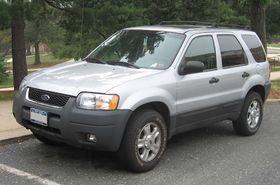 |
|
| Overview | |
| Also called | Ford Maverick Mazda Tribute Mercury Mariner (2005-2007) |
| Production | April 2000–December 2006 |
| Model years | 2001–2007 |
| Assembly | Japan: Hōfu, Yamaguchi (Mazda) United States: Avon Lake, Ohio (Ford) Claycomo, Missouri (Ford) Germany: Saarlouis Malaysia: Shah Alam (AMI)[1] Philippines: Santa Rosa, Laguna (Ford Philippines)[2] Taiwan: Zhongli (Ford Lio Ho) Vietnam: Hai Duong (Ford Vietnam) |
| Designer | Laurens van den Acker (1998)[3] |
| Body and chassis | |
| Platform | Ford CD2 platform |
| Powertrain | |
| Engine | 2.0 L Zetec I4 2.3 L Duratec 23 I4 3.0 L Duratec 30 V6[4] |
| Transmission | 5-speed G5M manual 4-speed CD4E automatic 4-speed GF4AX-EL automatic Hybrid: planetary gear |
| Dimensions | |
| Wheelbase | 103.1 in (2,619 mm) |
| Length | 2001–04: 173.0 in (4,394 mm) 2005–07: 174.9 in (4,442 mm) |
| Width | 70.1 in (1,781 mm) |
| Height | 2001–04: 69.1 in (1,755 mm) 2005–07: 69.7 in (1,770 mm) Hybrid: 69.7 in (1,770 mm) |
| Curb weight | 2WD: 3,247 lb (1,473 kg) 4WD: 3,457 lb (1,568 kg) |
The first generation of Ford Escape was released in 2000 for the 2001 model year. It was jointly developed with Mazda, in which Ford owned a controlling interest, and was released simultaneously with the Mazda Tribute. Both are built on the Ford CD2 platform, in turn based on the Mazda GF platform.
At the time, larger sport utility vehicles tended to use pickup truck-based, body-on-frame designs. Other car makers, Jeep and Toyota, had been offering smaller unibody designs, the Jeep Cherokee (XJ) and RAV4, respectively. Solid rear axles were commonly used due to their ability to carry heavy loads at the expense of a comfortable ride and good handling. Ford and Mazda then decided to offer a car-like, unibody design with a fully independent suspension and rack and pinion steering, the Escape.[5] Although not meant for serious off-roading, a full-time all-wheel-drive (AWD) system supplied by Dana was optional, which included a locking center differential activated by a switch on the dashboard.[6] The AWD system normally sends most of the power from the engine to the front wheels. If slipping is detected at the front, more power will be sent to the rear wheels in a fraction of a second. The four wheel drive system was a newer version of Ford's "Control Trac" 4x4 system, dubbed the Control Trac II 4WD in the Escape. This system allowed the front wheels to receive 100% of the torque until a slip was detected. Using a Rotary Blade Coupling, the rear wheels could be sent up to 100% of the power in fractions of a second. When switching the system from "Auto" to "On," the front and rear axles are locked at a 50/50 split; the reaction time necessary to engage the rear wheels is reduced via an integrated bypass clutch. The Control Trac II system allows for a four-wheel drive vehicle without the use of a center differential. The entire braking system was built by Continental Teves, including the ABS and various related suspension components.[7] CKD production began in 2002 at Ford Lio Ho Motor Co. in Taiwan for various Asian markets.[8]
One main difference between the Tribute and the Ford Escape is that the Tribute's suspension is tuned for a firmer ride than the Escape, in order to correspond with Mazda's sporty image.
Ford[edit]
- 2000–2004 (BA, ZA)
In North America, it slotted below the larger, truck-based Explorer in Ford's lineup, but was larger than the small SUV offerings from Honda and Toyota.[9] Although it is technically a crossover vehicle, it is marketed by Ford as part of its traditional SUV lineup (Escape, Explorer, Expedition) rather than its separate crossover lineup (Edge, Flex).
From 2001 to 2004, the Ford Escape was sold in Europe under the Maverick name, and replaced a rebadged version of the Nissan Mistral/Terrano II. Only two versions were made, the 2.0 L Zetec inline 4 engine with manual transmission and 3.0 L Duratec V6 with automatic transmission, both using gasoline as fuel. The absence of a diesel version did not help sales and the vehicle was temporarily discontinued in late 2003. However, the Maverick, in the UK for example, was only available in XLT trim. Plus, the dashboard was not the same as the US Escape; it was instead taken from the Mazda Tribute. The Maverick was reintroduced in 2005 in certain European markets with the Duratec V6 engine. It was announced that the Maverick would be assembled in Russia for the Russian market. As of 2006, the Maverick was no longer sold in Europe, leaving Ford without a compact SUV until the 2008 Ford Kuga was introduced. The Maverick was primarily designed for on-road use – sold with normal road tires, and to be used with front-wheel drive most of the time.
Crash test results for the Escape have been mixed. In the New Car Assessment Program administered by the USA-based National Highway Traffic Safety Administration, the car received five out of five stars for driver protection and four out of five stars for passenger protection in a 35 mph (56 km/h) frontal impact.[10] The SUV received five stars for both driver and rear passenger in the side impact test. In the Insurance Institute for Highway Safety's 40 mph (64 km/h) frontal offset test, 2001–2004 Escapes received a score of "Marginal".[11] In the side impact crash test, vehicles equipped with the optional side air bags received a score of "Good" in the 31 mph (50 km/h), while those without the optional air bags received a score of "Poor".[12]
All Escapes are equipped with a passive 'Immobiliser' called SecuriLock. This feature includes an 'RFID' chip embedded in the key which is read by the car each time the vehicle is started. If the vehicle fails to receive a valid confirmation signal from the key, the vehicle will not run, even if the key is perfectly cut to match the original. Theft, injury, and collision losses reported to insurance companies for the Escape are among the lowest in its class.[13]
- North America
In the United States, all Escapes included standard equipment such as power windows, power door locks, anti-lock braking system (ABS), keyless entry, a folding rear bench seat, 16-inch wheels, and air conditioning. In addition, an Escape buyer could choose from one of several different trim levels that were available, which included:
XLS (2001–2007): As the most basic trim level of the Escape, the XLS included: the 2.0-liter Zetec (2001–2004) and the 2.3-liter DuraTec (2005–2007) engines, a five-speed manual transmission, 15-inch steel wheels, an AM/FM stereo with cassette and CD players (later, a six-disc, in-dash CD changer) and four speakers, high-back front bucket seats, and cloth-and-vinyl seating surfaces. Options include 15- or 16-inch alloy wheels, the 3.0-liter V6 engine (2001–2004), and a four-speed automatic transmission (some of which was available as the XLS Popular Group).
XLT (2001–2007): As the top-of-the-line trim level of the Escape in 2001, and the most popular trim level of the Escape throughout its entire run (2001–2007), the XLT added the following equipment to the base XLS trim level: 16-inch alloy wheels, cloth seating surfaces, and an enhanced interior. Options included an AM/FM stereo with a six-disc, in-dash CD changer (which later became standard equipment on all Escapes), the 3.0-liter V6 engine, a four-speed automatic transmission, a power sunroof, leather-and-vinyl-trimmed seating surfaces, and the seven-speaker premium audio system with amplifier and rear-mounted subwoofer.
XLT Sport (2002–2007): The XLT Sport was one of the more popular trim levels of the Escape from 2002 to 2007. It added equipment to the standard XLT equipment: the V6 engine, four-speed automatic transmission, sport interior trim, and 16-inch machined alloy wheels. Options were the same as the standard XLT trim level.
Limited (2003–2007): As the top-of-the-line trim level of the Escape from 2002–2007, the Limited trim level added the following equipment to the XLT Sport trim level: an AM/FM stereo with six-disc in-dash CD/MP3 changer, the seven-speaker premium audio system with amplifier and rear-mounted subwoofer, low-back front bucket seats, leather-trimmed seating surfaces, dual power heated front bucket seats, a security system, color-keyed exterior trim, luxury interior trim, and a unique front grille. Options were limited, but included a power sunroof.
Hybrid (2005–2007): Based on the midrange XLT trim level, the Hybrid included: the 2.3-liter DuraTec inline-four engine with an electric motor, power front bucket seats, low-back front bucket seats, enhanced partially-recycled cloth seating surfaces, and unique 16-inch alloy wheels. Options included a power sunroof, a unique integrated GPS navigational system with hybrid information system, Sirius Satellite Radio, the seven-speaker premium audio system with amplifier and rear-mounted subwoofer, leather-trimmed seating surfaces, and a "two-tone" exterior paint scheme, with silver-painted lower exterior trim and front and rear bumpers.
- 2004–2006 (ZB)
The Escape and Tribute were updated in February 2004 for the 2005 model year with a new base engine (the 2.3 L [2261 cc, 140 cu in] Duratec 23), which replaced the Zetec 2.0 L (1983 cc, 121 cu in) 127 hp (95 kW) 4-cylinder. The most powerful engine remained the 200 hp (150 kW) Duratec 3.0 L (2976 cc, 181 cu in) V6, with new engine mounts. Ford also added advanced airbag and seatbelt safety systems, an intelligent AWD system, and exterior changes, which included a redesigned front bumper. The 2005 model year was the first with an automatic transmission available on the base four-cylinder models. The automatic shifter was moved from the column to the console on all models equipped with automatic transmissions. Ford also deleted the recline feature on the rear seats to improve the safety of occupants in the rear seats in the case of a rear crash.
- 2006–2008 (ZC; Asia-Pacific)
A revamped ZC Escape designed in Taiwan went on sale in the second half of 2006 for the Asian and Pacific markets (except South Korea, where the North American-market Escape is sold).[14] Major external changes included a redesigned front bumper, grille, headlights and hood, and rear bumper, as well as LED taillights.
On the inside, changes included a floor-mounted automatic transmission shifter, in place of the column shifter, as well as a redesigned center stack containing audio and climate controls. Climate control is automatic on all models except the XLS. The Limited model also featured full color-coded bumpers, wheel arches and side moldings, as well as side mirrors with integrated LED indicators. Rear drum brakes have been replaced by disc brakes all round.
The 3.0 L V6 has been modified to reduce fuel consumption by over 10%,[citation needed] while the 2.3 L 4-cylinder has improved midrange torque and an electronic throttle, as well as a slight increase in power to 109 kW (146 hp). Both engines had been certified to meet Euro III emission regulations. A four-speed automatic carried over and was the sole transmission choice. Two different four-speed automatic transmissions were used, CD4E for 3.0 L V6 and GF4AX-EL for 2.3 L 4-cylinder.
- 2008–2009 (ZD; Asia-Pacific)
The ZD Escape went on sale in mid-2008, bringing numerous changes. In Australia, the V6 engine was dropped, leaving only the 2.3-liter four-cylinder.[15]
The model range was also simplified, with only a single specification available. Changes to the body included an all-new front bumper, grille, headlights and bonnet, featuring an enlarged Ford emblem set upon a three-bar chrome grille. At the rear, new, slimmer tail lights were featured, which were arranged horizontally, rather than vertically. In addition, the B-pillar was now painted black, rather than body-colour. Compared with the previous model, all external bumpers, mirrors, and cladding were painted the same colour as the body (previously, this was only available on the upscale Limited model). Equipment levels have also improved. Compared to the base model ZC Escape, the ZD included standard side airbags, automatic climate control, 16" alloy wheels, and mirrors with integrated indicators. Unlike most other competitors in its class, curtain airbags and electronic stability control were not available.
- 2009–2012 (ZD; Asia-Pacific)
In 2009, another facelift of the ZD Escape brought about a new grille and front bumper. Chrome trim was completely removed from the grille, replaced with a smaller, black honeycomb grille as the last ever Ford Escape. In its final years, it was sold side by side with its successor, Ford Kuga until the Kuga replaced it in 2013.
Mazda[edit]
- 2000–2004
The Tribute made its debut at the 2000 Los Angeles Auto Show as a compact crossover SUV, a segment pioneered by the Toyota RAV4 in 1994. It was the first SUV offered by Mazda since the Mazda Navajo, a rebadged two-door Ford Explorer which was retired after the 1994 model year. In Japan, Mazda had an SUV called the Mazda Proceed Levante, a rebadged Suzuki Escudo, but the Tribute was Mazda's first original SUV. The Ford plant in Claycomo, Missouri assembled Tribute for the North American market, alongside Ford Escape. The Mazda plant in Hofu, Japan and the Ford Lio Ho plant in Taiwan assembled Tribute for their respective markets.
The 2001–2006 Mazda Tribute was available as front- or four-wheel drive and featured a plain-looking but comfortable roomy interior, decent handling and car-like ride. The Tribute and Escape debuted in 2000, offering front or all wheel drive and a choice of a transversely mounted 2.0 L Ford Zetec 4-cylinder engine with 129 PS (95 kW)/183 N·m (135 lb·ft), or 3.0 L Ford Duratec V6 with 203 PS (150 kW)/265 N·m (195 lb·ft). The 2.0 L 4-cylinder engine had Timing belt driven Camshafts, while the 3.0 L Duratec V6 featured a maintenance-free timing chain.[16]
- 2004–2006
Both the Escape and Tribute were refreshed in 2004 for the 2005 model year. The base engine became the Mazda 2.3 L MZR 4 with 153 PS (114 kW)/206 N·m (152 lb·ft), and the top remained the 3.0 L Duratec V6, now with torque down to 261 N·m (193 lb·ft). In North American-built models, a floor-mounted automatic transmission shifter replaced the column shifter. However, Japanese-built models continued with a column shifter. Mazda decided to halt production after the 2006 model year
Mazda Japan released a limited version, the Mazdaspeed Tribute, in the year 2004 with a 2.3-liter MZR engine that has 220 PS (164.05 kW)/ 254 N·m (195 lb·ft) that is utilized by a column shifter. However, Mazda Japan decided to end its production in 2005.
- 2006–2008 (Asia-Pacific)
A significantly face-lifted version of the Tribute was released in the second half of 2006 for Asia Pacific markets. The updated Tribute featured a larger, bolder grille, with an enlarged Mazda emblem, as well as restyled front bumper and headlights. Side mirrors featured integrated indicators.
On the inside, changes included a new floor mounted automatic transmission shifter, in place of the old column shifter (Asia-Pacific model only; US-built Tribute gained the floor shifter in 2005). The dash was updated with a brand-new radio and automatic climate control with digital read-out, on certain models. Mechanically, the rear drum brakes were replaced by disc brakes. Engines remain the same, but the V6 has been modified to reduce fuel consumption by over 10%, while the 4-cylinder has improved mid-range torque and an electronic throttle. Both engines had been certified to meet Euro III emission regulations.
Starting from 2006, Mazda stopped selling and producing Tribute in Japan, and replaced it with similar sized CX-7. In 2008 Mazda Australia also discontinued the Tribute, the absence of the Tribute being filled by the Mazda CX-7 introduced in the previous year. For other Asia-Pacific markets, the production of Tribute was shifted to the Ford Lio Ho plant in Zhongli, Taiwan, which also produces Tribute's twin, Ford Escape, for Asia-Pacific markets. This arrangement continued until early 2010, when the Tribute for the Asia-Pacific markets ceased production, being fully replaced by the CX-7 imported from Japan.
Mercury[edit]
Introduced in 2004 for the 2005 model year refresh of the Ford Escape in the US, Ford's Mercury division released a luxury version called the Mercury Mariner. The Mariner sits above the Escape in the Ford-Mercury-LINCOLN hierarchy. The Mariner is Mercury's first car-based SUV, and is slotted below the Mountaineer in the lineup. The Mariner was officially offered in the US, Mexico, Saudi Arabia, Kuwait, and the UAE. The Mercury includes stylistic differences, such as a two-tone interior, turn signal repeaters borrowed from the European-market Ford Maverick (the Escape's name in Europe), monotone cladding, and the signature Mercury "waterfall" front grille. Unlike its counterparts, a manual transmission was not part of the powertrain lineup. The Mariner was the first Mercury with a four-cylinder since the Mercury Cougar was dropped in 2002. For 2006, the lineup was expanded with the introduction of the Mariner Hybrid. Sales ended after the 2007 model, replaced by a second generation, again a rebadged Ford Escape.
On September 7, 2006 Ford delivered a special "Presidential Edition" Mercury Mariner Hybrid to former President Bill Clinton. Its custom features include: LED lighting, 110-volt outlet, rear bucket seats, center console & rear seat fold-out writing desks, personal DVD players for each seat, refrigerator, increased rear seat legroom. There have also been several undisclosed security modifications made to the vehicle.[17]
The Mariner Hybrid powertrain was identical to its sibling, the Ford Escape Hybrid. It was launched to the U.S. market in 2006 and was discontinued in 2010 (in the second generation) with the rest of the brand. The Mariner hybrid sold a total of 12,300 units.[18]
Like the Ford Escape Hybrid, the Mariner Hybrid is a "full" hybrid electric system, meaning the system can switch automatically between pure electric power, pure gasoline engine power, or a combination of electric battery and gasoline engine operating together, for maximum performance and efficiency at all speeds and loads. When braking or decelerating, the Mariner's hybrid system uses regenerative braking, where the electric drive motor becomes a generator, converting the vehicle's momentum back to electricity for storage in the batteries. With 155 hp (116 kW), the Mariner Hybrid has nearly the same acceleration performance as the conventional 200 hp (150 kW) V6 Mariner. Again, just like the Escape Hybrid, it gets a respectable average of 34 miles per US gallon (6.9 L/100 km; 41 mpg‑imp) and is sometimes said to be the most fuel efficient sport utility vehicle on the road.[19]
Hybrid[edit]
The Ford Escape Hybrid and Mercury Mariner Hybrid are the gasoline-electric hybrid powered versions that launched in the U.S. in 2004 for the 2005 model year. Built in Kansas City, Missouri, it was the first hybrid SUV to hit the market. The Ford Escape Hybrid was the first American-built hybrid and the first hybrid vehicle from an American automaker, joined by the Chevrolet Silverado/GMC Sierra Hybrids during the same model year. According to the Environmental Protection Agency, the first generation Ford Escape Hybrid is 70% more efficient than the regular Escape. The Mercury Mariner Hybrid is a rebadged version of the Escape Hybrid. It features revised front-end styling and a more luxurious interior.
Escape hybrid versions can be identified by the "Hybrid" badges located on the front driver's and passenger's doors as well as near the right tailgate. In addition, the driver's side window in the cargo area is smaller in size in order to accommodate a ventilation slot for the high voltage battery. There was also a "Special Appearance Package" available as an option on the 2005–2007 Hybrid models. This package replaced the traditional lower cladding of the Escape with a silver finish. Standard equipment on the Escape Hybrid includes: an eight-way power adjustable driver's seat, dual-zone automatic air conditioning, cruise control, a six-CD stereo, 16-inch alloy wheels, power door locks with remote keyless entry, and power windows.
Ford built 17,000 Escape Hybrids in the second half of 2004, four times as many as it had originally planned.[20] Starting in 2005 New York City and other cities in the world began using the Ford Escape Hybrid as taxicabs.[21] The Ford Escape Hybrid won the North American Truck of the Year award in 2005.[22]
The Escape Hybrid uses technology similar to that used in the Toyota Prius. Ford engineers realized their technology may conflict with patents held by Toyota, which led to a 2004 patent-sharing accord between the companies, licensing Ford's use of some of Toyota's hybrid technology[23] in exchange for Toyota's use of some of Ford's diesel and direct-injection engine technology.[24] Ford maintains that Ford received no technical assistance from Toyota in developing the hybrid powertrain, but that some hybrid engine technologies developed by Ford independently were found to be similar to technologies previously patented by Toyota, so licenses were obtained.[24] Aisin Seiki Co. Ltd., a Japanese automotive components supplier belonging to the Toyota Group, supplies the HD-10 hybrid continuously variable transmission for the Escape Hybrid. While Toyota produces its third-generation Prius transmission in-house, Aisin is the only supplier of hybrid transmissions to other manufacturers. Friction has arisen concerning Aisin's allocation of limited production capacity and engineering resources to Ford.[24] Sanyo Electric Co. built the 50 kg (110 lb), 330 volt[25] 5.5 Ah (would make it 1.8kWh storage), 250-cell nickel metal hydride (NiMH) battery pack for the 2005 Escape Hybrid.[26]
The Escape Hybrid is a full hybrid, meaning the system can switch automatically between pure electric power, pure gasoline engine power, or a combination of electric battery and gasoline engine operating together, for maximum performance and efficiency at all speeds and loads. When braking or decelerating, the Escape's hybrid system uses regenerative braking, where the electric drive motor becomes a generator, converting the vehicle's momentum back to electricity for storage in the batteries. The Escape Hybrid's 133 horsepower (99 kW) gasoline I4 engine and electric motor combine to give 155 hp (116 kW), which gives the Hybrid Escape nearly the same acceleration performance as the conventional 200 hp (150 kW) V6 Escape due to the electric motor's torque being available from zero rpm.
The hybrid is said to give approximately 75% greater efficiency, the FWD version has EPA ratings of 30 mpg and 28 highway, with combined 29 mpg. The AWD version EPA ratings 28 city and 26 highway, combined 27 mpg -U.S. in city traffic, and has demonstrated it can travel 400–500 miles (644–805 km) on a single 15.0-U.S.-gallon (57 L; 12.5 imp gal) mpg-U.S. (7.6L-8.1 L/100 km; 35–37 mpg-imp) on the highway. To obtain these mileage figures, the owners manual states that pure gasoline, not ethanol blends, must be used. Unlike conventional vehicles, hybrids often achieve better figures in the city because they do not waste power idling and can recover some power when stopping (by using regenerative braking) that would be wasted in a conventional vehicle.
In 2006, Ford showed an Escape that could run on E85 fuel.
Second generation (2008–2012)[edit]
| Second generation | |
|---|---|
_(cropped).jpg) |
|
| Overview | |
| Also called | Mazda Tribute (2008-2011) Mercury Mariner (2008-2011) |
| Production | January 29, 2007-April 2012 |
| Model years | 2008–2012 |
| Assembly | Claycomo, Missouri, United States |
| Designer | Doyle Letson[27] |
| Body and chassis | |
| Platform | Ford CD2 platform |
| Powertrain | |
| Engine | 2.3 L Duratec 23 I4[4] 2.5 L Duratec 25 I4 3.0 L Duratec 30 V6[4] |
| Transmission | 5-speed manual 4-speed CD4E automatic 6-speed 6F35 automatic Hybrid: Planetary gear |
| Dimensions | |
| Wheelbase | 103.1 in (2,619 mm) |
| Length | 174.7 in (4,437 mm) |
| Width | 71.1 in (1,806 mm) |
| Height | 2008: 67.7 in (1,720 mm) 2009–12 AWD: 67.8 in (1,722 mm) 2009–12 FWD: 67.9 in (1,725 mm) |
The second generation Ford Escape debuted at the 2006 Los Angeles International Auto Show.[28] The North American-market Escape and its Mazda Tribute and Mercury Mariner siblings were redesigned in order to stay competitive with other new compact SUVs, however most of the internals have been carried over for the 2008 model year. The Escape still uses the CD2 platform.[29] Ford also included an electronic stability control system standard on the 2008 Escape.[30]
The updated Escape received some styling cues from the Explorer, Edge, and Expedition. Changes include a new grille with larger headlamps in the front fascia, while the sides were revised with cleaner lines and rounder wheel arches. The interior is also completely redesigned, including the newest standard Ford family navigation system.[31]
The 2008 Escape and its Mercury Mariner sibling were the first vehicles to feature Ford's pull-drift steering mode, an enhancement made possible by applying software control to the Electric Power Steering (EPS) system.[32]
On June 23, 2010, it was announced that Ford will end production on the second generation Escape in 2011 and move production to its Louisville Assembly Plant in Louisville, Kentucky, where it is slated to be succeeded by a Taiwanese version of its European CUV counterpart, the Ford Kuga.[33]
Ford[edit]
A new concept version for the Asian market, called the Ford Escape Adventure Concept, was revealed at the 2007 Tokyo Motor Show. It features a revised front and rear fascia, incorporating Ford's three-bar grille styling theme and restyled LED tail lamps.[34]
The 2.3 L Duratec 23 was replaced by a new 2.5 L (2488 cc, 152 cu in) Duratec 25,[35] which boosted standard power to 171 hp (128 kW) and 171 lb⋅ft (232 N⋅m) of torque, while increasing fuel economy by 1 mpg (~2L/100 km) on both urban and extra-urban cycles. The optional 3.0 L Duratec 30 V6 was thoroughly updated, resulting in a 40 hp (30 kW) increase, bringing power output to 240 hp (180 kW) and 223 lb⋅ft (302 N⋅m) of torque. The Duratec 30 also sees a 1 mpg‑US (240 L/100 km; 1.2 mpg‑imp) fuel economy improvement. The "Escape" badge is entirely removed from the front doors.
The Hybrid is also upgraded to use the 2.5 L (albeit still using the Atkinson cycle for better fuel economy). Efficiency improved to 34 mpg‑US (6.9 L/100 km; 41 mpg‑imp) city and 31 mpg‑US (7.6 L/100 km; 37 mpg‑imp) highway according to the USEPA. The 2.5 L engine brings the Hybrid's power output up by 22 hp (16 kW) when the electric motor is added in.
Other mechanical changes include a new 18.5 mm (0.73 in) rear stabilizer bar, revised suspension tuning, upgrades to the 3.0 L V6 that brought power to 240 hp,[35] and a new exhaust system on all Escapes. The braking system for the Hybrid versions has been revised with a vacuum assist unit that reviewers have said give the brakes a consistent feel over the entire travel of the brake pedal.[35] Previous versions of the Hybrid were reported to have a slightly mushy brake feel, primarily due to the fact that for the first part of the brake travel and braking the system is regenerating power instead of engaging the brake pads against the rotors. However, the brakes, when tested, gave the Escape extremely long stops.
Also in 2009, Ford's SYNC system is standard on the Hybrid, Hybrid Limited, and conventional Limited models, and optional on the XLS and XLT.
The Escape underwent some minor aerodynamic changes for 2009, including a revised front chin spoiler and rear tire spoilers. Along with the addition of rear tire spoilers is an optional 17" chrome-clad wheel equipped with a new Michelin "Low-Rolling-Resistance-Tire", slightly increasing ground clearance and improving traction over the standard 16" wheels and tires. Another new feature is Ford's Easy-Fuel capless fuel filling system.[36]
As of August 2009 the Escape was among the four Ford vehicles, along with the Focus, F-Series and Ranger, to benefit the most from the Cash for Clunkers program, where it showed a 49 percent increase in sales.[37]
In 2009 for the 2010 model year, the Escape will add three new features that will be standard on all trims: Ford's MyKey, trailer sway controls and Integrated Spotter Mirror for better blind spot viewing. Everything else added in the 2008 and 2009 model years will be carried over, but the optional orders have been renamed to Rapid Specification Codes (100s for XLS, 200s for XLT, and 300s for Limited).
New optional features for 2010: active park assist (APA) is a new feature available since mid-2009 as an option on the 2010 Ford Escape Limited (currently only optional on the Ford Flex, LINCOLN MKT, and LINCOLN MKS). Active Park Assist will detect an available parallel parking space and automatically steer the vehicle into the space (hands free) while the driver controls the accelerator, gearshift and brakes. The system will visually and audibly instruct the driver to park the vehicle. Active Park Assist system uses sensors on the front and rear of the vehicle to guide the vehicle into a parking space. Rear-view camera system – uses an exterior camera embedded in the rear of the vehicle that sends images to a video display in the rearview mirror or the navigation system screen to help enhance visibility directly behind the vehicle when it is in reverse.
No cosmetic changes were made for the 2011 model year. The only minor change is the standardization of SYNC Traffic & Directions on any models coming equipped with Sync.[38]
There are no cosmetic or equipment changes for the 2012 model year. The third-generation Escape was unveiled at the 2012 North American International Auto Show in Detroit.
Previously unavailable Electronic Stability Control system became standard on the second generation.[39] In Insurance Institute for Highway Safety crash tests the Escape along with its cousins, the Mercury Mariner and the Mazda Tribute, are rated "Good" in both frontal and side impact crash tests.[40][41] They are rated "Good" for rear crash protection as well[42] and were given the "Top Safety Pick" award until 2010. In roof strength tests the Escape receives a "Marginal" rating while hybrid models are rated "Poor".[43]
Mazda[edit]
In 2007 for the 2008 model year, the Tribute was significantly revamped, like its Ford Escape and Mercury Mariner siblings. Originally set to be renamed the Mazda CX-5, the vehicle kept the Tribute name. The changes were significant, but fell short of a "clean sheet" redesign, as the vehicles remained on the CD2 platform, and kept the old 2.3 L MZR I4, and 3.0 L AJ V6 engines. Visible changes include all new sheet metal and interior. The interior was significantly upgraded using all new components and higher quality materials, and was generally praised by automotive journalists.[44] However, unlike the first generation of the Tribute, which had unique exterior and interior from its siblings, the new model only differs from its siblings in the "nose" (front fenders, hood, and front fascia), tail lights and detailing. Notable changes to the exterior include higher belt line, and more pronounced wheel arches. Overall the car was to look larger and more substantial than the previous model. As a cost-saving measure, the rear brake was reverted to drum brake, with predictable criticisms.[45][46]
The 2008 Mazda Tribute (non-hybrid) was first unveiled at the 2007 Montreal International Auto Show, and the 2008 Mazda Tribute went on sale in March 2007.[47]
A new addition was the Hybrid model which was previously only available on the Ford Escape and Mercury Mariner.
The Tribute received additional major changes to improve performance for the 2009 model year, mostly by way of mechanical upgrades. Most significantly, all new engines replaced the increasingly outmatched 2.3L I4 and 3.0L V6. Mazda's new MZR 2.5L I4 replaced the 2.3L, boosting horsepower to 171 bhp (128 kW; 173 PS) and 171 lb⋅ft (232 N⋅m) of torque at 4000 rpm.[48] Despite increased horsepower, fuel economy also increased by 1 mpg‑US (240 L/100 km; 1.2 mpg‑imp) on both urban and extra-urban cycles. The optional 3.0 L (AJ) V6 was thoroughly updated, resulting in a 40 hp (30 kW) increase, bringing power output to 240 hp (180 kW) and 223 lb⋅ft (302 N⋅m) of torque. It also sees a 1 mpg improvement. The Tribute Hybrid was dropped after the 2009 model year.
Another significant change was the switch to Ford's new 6F 6-speed automatic, which became standard on all V6 equipped models and optional on the I4. As well, new front and 18.5 mm (0.73 in) rear stabilizer bars were added for 2009 to improve ride handling after complaints about diminished performance following the 2008 changes. Others changes included redesigned seats, daytime running lamps, optional steering mounted audio controls, and other additional features. The Tribute was discontinued in November 2011 at the end of the 2011 model year, replaced by the Mazda CX-5 for 2012.
Mercury[edit]
For the 2008 model year the Mariner was significantly updated with a new look although it remained on the Ford CD2 platform used by the previous generation. The first 2008 Mercury Mariner was unveiled at the South Florida International Auto Show on October 6, 2006. The changes included a new seats, headlights, taillights, a new liftgate, a higher beltline and new doors and wheels. The interior was also significantly updated with higher quality materials and more refined features. The engines remained the same but the 3.0 L Duratec V6 has been modified to reduce fuel consumption by 10%.
The 2009 Ford Escape and Mercury Mariner were unveiled at the 2008 Washington Auto Show. Sporting a 2.5-liter engine and 6-speed automatic transmission that replaced the four-speed automatic transmission, the new powertrain improved the EPA fuel economy by 1 mile per gallon and increased power by 11% to 170 horsepower (130 kW). Also, the existing 3.0-liter Duratec V6 was bumped from 200 hp (150 kW) to 240 hp (180 kW). The new engine was also the new basis for Ford's hybrid models, including the Ford Escape Hybrid and Mercury Mariner Hybrid. "For every eight Escape and Mariner vehicles we sell, one of them is a hybrid, and the appeal is growing," says Sue Ciscke, Ford senior vice president, Sustainability, Environment and Safety Engineering.
For the 2010 model year, the Mariner added Ford's MyKey and trailer sway controls as standard on all trim levels. The Mariner engine has a Flex-Fuel option on all of them which features being able to use E85 fuel and/or regular unleaded only on the optional V6 engine. Ford has also done away with the Euro-style turn signal repeaters for this model year. For the 2011 model year, the Mariner featured HD Radio as a standard, but continued with the same features as the 2010 models. This version of the Mariner was its last, as Ford discontinued the Mercury brand due to declining sales. Ford ended production of the Mariner in October 2010. The last one rolled off the assembly line on October 5, 2010.
Hybrid[edit]
The second generation Ford Escape Hybrid received some styling tweaks inside and out. The major cosmetic changes included new bumpers, grille, headlights and taillights to match Ford's new edge style. But the drivetrain was essentially the same mechanically but has had extensive software modifications.[49] For 2009, a larger, more powerful engine was introduced, together with a revised suspension, addition of stability control, the debut of "Sync" voice-control system and a capless fuel filler system.[50] The batteries and other hybrid components in a 2009 Escape hybrid added about 136 kg (300 lbs) to the vehicle. However, the added weight was blamed for an adverse effect in handling.[51] Furthermore, from 2009 onward, rear disc brakes of previous years were swapped for drum brakes, which was criticized as a "strange step backward".[50]
The second generation Escape Hybrid was offered in two levels of specification, an undesignated base model and the more expensive "Limited" trim. The base included: a 60/40 split-fold rear bench seat, AdvanceTrac with roll stability control, and a single-disc four-speaker CD/MP3 stereo with Sirius Satellite Radio compatibility. The "Limited" adds: a chrome front grille, heated front seats, a six-way power driver's seat and full leather upholstery, rear park assist, ambient lighting, and 16-inch six-spoke alloy wheels. For the 2009 model year, Ford SYNC became standard on both Hybrid trims and the Ford Escape Hybrid replaced the "ESCAPE" badges on doors with "HYBRID," while relocating the logo for Ford hybrid models from near the driver's side doors next to the "HYBRID" text. 2010 models saw the addition of MyKey, trailer sway controls, and integrated spotter mirror for better blind spot viewing. New optional extras are active park assist and a rear-view camera.
Ford announced the development of a prototype E85 Hybrid Escape, the first flexible fuel hybrid electric vehicle capable of running on 85% ethanol.[52] In 2007 Ford produced 20 demonstration Escape Hybrid E85s for real-world testing in fleets around the U.S.[53][54]
From 2009, the gas engine was 2.5L Atkinson-cycle four cylinder engine with 155 hp at 6,000 rpm with an electric motor that produces 94 hp at 5,000 rpm. The maximum combined output of both was 177 hp.[55]
The U.S. Environmental Protection Agency (EPA) rated the fuel economy for the 2010 Escape Hybrid (FWD) at 34 miles per US gallon (6.9 L/100 km; 41 mpg‑imp) city, and 31 miles per US gallon (7.6 L/100 km; 37 mpg‑imp) highway.[56] The following table compares fuel economy, carbon footprint, and petroleum consumption between the hybrid version and other drivetrains of the Escape family as estimated by the EPA and the U.S. Department of Energy. The Escape Hybrid met both California's SULEV and PZEV standards, with tailpipe emissions better than 90% less than the average 2003 new car and zero evaporative emissions.[57]
By early 2012 Ford discontinued the production of the Escape Hybrid due to the introduction of the third generation Escape. Two of the new 2013 model year Escapes have direct-injected and turbocharged EcoBoost units (of 1.6 and 2.0 liters) that deliver a higher fuel economy than the 2012 model. A total of 122,850 Escape Hybrids were built since 2005, along with 12,300 units of its sibling the Mercury Mariner Hybrid, discontinued in 2010.[58]
- Plug-in hybrid
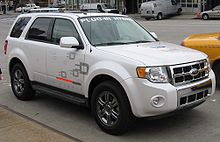
Three companies have converted Ford Escape Hybrids to plug-in under a contract with the NYSERDA and delivered them in 2007: Electrovaya of Toronto Canada, Hymotion also of Toronto Canada, Hybrids Plus of Boulder Colorado, United States.[59]
Ford developed a research Escape Plug-in Hybrid and delivered the first of a fleet of 20 to Southern California Edison (SCE) in December 2007 to begin road testing. This project is a collaboration aimed to explore the future of plug-in hybrids and evaluate how the vehicles might interact with the home and the utility's electrical grid. Some of the vehicles will be evaluated "in typical customer settings", according to Ford.[60][61][62] Ford also developed the first ever flexible-fuel plug-in hybrid SUV, which was delivered to the United States Department of Energy in June 2008. This plug-in version of the Escape Hybrid runs on gasoline or E85 and is also part of the demonstration fleet Ford developed in a partnership with Southern California Edison and the Electric Power Research Institute.[63]
Both the E85 version and the conventional gasoline engine version use a 10 kwh lithium-ion battery, which allows for a 30-mile (48 km) range at 40 miles per hour (64 km/h) or less. When the battery's charge drops to 30%, the vehicle switches to its four-cylinder engine, assisted by the batteries, operating as a regular hybrid electric vehicle. The vehicle has a display system which shows the driver how efficient the vehicle is at any given time. If the vehicle uses its engine and is running in traditional hybrid mode, fuel economy is rated at 88 miles per U.S. gallon (2.7 L/100 km; 106 mpg‑imp) in the city and 50 miles per U.S. gallon (4.7 L/100 km; 60 mpg‑imp) on the highway.[63][64]
This fleet of 20 Ford Escape Plug-ins has been running in field testing with utility company fleets in California, New York, Ohio, North Carolina, Alabama, Georgia, Massachusetts, Michigan, and Quebec, Canada. About 130 more will be produced for testing with financing from a $30 million grant from the U.S. Department of Energy. Sales are scheduled for 2012.[64][65]
On August 2009 Ford delivered the first Escape Plug-in equipped with intelligent vehicle-to-grid (V2G) communications and control system technology to American Electric Power of Columbus, Ohio. This technology allows the vehicle operator to program when to recharge the vehicle, for how long and at what utility rate. The battery systems communicate directly with the electrical grid via smart meters provided by utility companies through wireless networking.[66] During the two years since the demonstration program began, the fleet of Escape Plug-ins has logged more than 75,000 miles (121,000 km), and Ford plans to equip all 21 plug-in hybrid Escapes with the vehicle-to-grid communications technology.[66]
The Ford demonstration vehicles and Hybrids Plus conversions are similar. The conversion involves the replacement of the original NiMH battery, located on the floor of the trunk, with a larger capacity Li-ion battery, in the same location and substantially the same volume as the original battery. The Electrovaya and Hymotion conversions retain the original battery, and augment its capacity with a Li-ion battery that occupies a significant portion of the trunk. In all cases, the conversion also involves the addition of a charger and of a power plug.
Third generation (2013–present)[edit]
The third generation was designed and rebadged by Ford of Europe alongside the largely identical European-market Ford Kuga.[67][68] It was released to North American markets in 2012 for the 2013 model year. Other markets that previously used the "Escape" nameplate have switched to "Kuga" under the One Ford program.
Sales[edit]
| Calendar year | US sales | |
|---|---|---|
| Ford Escape | Mercury Mariner | |
| 2000[69] | 42,635 | |
| 2001[70] | 164,184 | |
| 2002[71] | 145,471 | |
| 2003 | 167,678 | |
| 2004 | 183,430[72] - (inc. 2,993 hybrids) | 7,171[73] |
| 2005 | 165,122[72] - (inc. 18,797 hybrids) | 34,099 |
| 2006 | 157,395[74] - (inc. 20,149 hybrids) | 33,941[75] |
| 2007 | 165,596 - (inc. 21,386 hybrids) | 34,844 |
| 2008 | 156,544[76] - (inc. 17,173 hybrids) | 32,306[77] |
| 2009 | 173,044[78] - (inc. 14,787 hybrids) | 28,688[79] |
| 2010 | 191,026[80] - (inc. 11,182 hybrids) | 29,912[81] |
| 2011 | 254,293[82] - (inc. 10,089 hybrids) | |
| 2012 | 261,008[83] - (inc. 1,441 hybrids)[84] | |
| 2013 | 295,993[85] | |
| 2014 | 306,212[86] | |
| 2015 | 306,492[87] | |
| 2016 | 307,069[88] | |
| 2017 | 308,296[89] | |
References[edit]
- Jump up ^ "Ford Escape to Go on Sale in August". autoworld.com.my. March 23, 2001. Archived from the original on May 16, 2015. Retrieved May 16, 2015.
- Jump up ^ Sarne, Vernon (June 27, 2012). "Ford makes 'business decision' to stop manufacturing cars in PH". Top Gear Philippines. Retrieved June 3, 2013.
- Jump up ^ Revill, John. "Maeda named new Mazda design boss, replacing van den Acker". Automotive News. Retrieved 17 October 2017.
- ^ Jump up to: a b c "Ford Escape: Specifications & Capacities for 2009 Models". Ford Vehicles. Archived from the original on April 11, 2009. Retrieved May 2, 2009.
- Jump up ^ "2001 Escape First Drive". Edmunds.com. January 1, 1999. Retrieved February 19, 2015.
- Jump up ^ "Dana Gets 4WD Contract for Ford/Mazda SUVs". Autoparts Report. April 25, 2000. Retrieved April 15, 2008.
- Jump up ^ "Continental Teves Supplies Brake System To Ford Escape/Mazda Tribute". Autoparts Report. June 2, 2000. Retrieved April 15, 2008.
- Jump up ^ "Dana Corp. To Supply 4wd System 2002 For Ford Escape in Taiwan – Brief Article". Autoparts Report. Highbeam Business. January 11, 2002. Retrieved February 24, 2015.(registration required)
- Jump up ^ Jamieson, Scott (August 2001). "Escaping debt: a reasonably priced alternative to full-sized pickups and SUVs, the Ford Escape has all the power and comforts required". Canadian Forest Industries. Retrieved April 15, 2008.
- Jump up ^ "New Car Assessment Program: 2001 Ford Escape". National Highway Traffic Safety Administration. 2001. Retrieved April 16, 2008.
- Jump up ^ "IIHS-HLDI: Ford Escape". IIHS-HLDI. 2001. Retrieved April 16, 2008.
- Jump up ^ "IIHS-HLDI: Ford Escape". IIHS-HLDI. 2003. Retrieved April 16, 2008.
- Jump up ^ "Injury, Collision, & Theft Losses 2001–2003" (PDF). HLDI. September 2004. Retrieved April 16, 2008.
- Jump up ^ "Ford Thailand has launched a revised Escape suv". AUTO in CAR. Autoincar.blogspot.com. September 27, 2007. Retrieved May 2, 2009.[dead link]
- Jump up ^ Brogan, Matt (August 25, 2008). "2008 Ford Escape XLT Review". CarAdvice. Retrieved May 13, 2016.
- Jump up ^ "2001–2011 Mazda Tribute". Samarins.com. Retrieved May 13, 2016.
- Jump up ^ "Clinton to get custom hybrid SUV". CNN. September 7, 2006. Retrieved November 9, 2009.
- Jump up ^ John Voelcker (May 22, 2012). "Green-Car Death List: 2012 Models To Which We Bid Adieu". Green Car Reports. Retrieved May 23, 2012.
- Jump up ^ "2009 Mercury Mariner Hybrid Review". Automoblog.net. Retrieved January 5, 2009.
- Jump up ^ Hybrid Sales Figures/Tax Credits for Hybrids Electric Drive Transportation Association. Retrieved August 24, 2007.
- Jump up ^ "FORD ESCAPE HYBRID TAXIS | Ford Motor Company Newsroom". Media.ford.com. Archived from the original on December 8, 2007. Retrieved June 9, 2012.
- Jump up ^ "NACTOY – Past Finalists & Winners". The North American Car and Truck of the Year Awards. Archived from the original on June 5, 2010. Retrieved July 13, 2010.
- Jump up ^ "Wall Street Journal Online – Toyota to License Hybrid Patents For Use by Ford – MARCH 9, 2004". The Wall Street Journal. March 9, 2004. Retrieved August 4, 2011.
- ^ Jump up to: a b c Cars.com – Ford Slams Toyota on Hybrids – Reported by Christine Tierney, Detroit News, August 8, 2005
- Jump up ^ "Escape specs". Ford. Archived from the original on 2008-06-28.
- Jump up ^ "2005 Ford Escape Hybrid Electric Vehicle" (PDF). HEV America, U.S. Department of Energy Advanced Vehicle Testing Activity. 2005. Retrieved August 7, 2007.
- Jump up ^ Siler, Steve. "2008 Ford Escape". Car and Driver.
- Jump up ^ "Ford toughens Escape for 2008". AutoWeek.com. Retrieved November 29, 2006.
- Jump up ^ "2008 Ford Escape gets new look". Edmunds.com. Archived from the original on December 11, 2006. Retrieved March 16, 2006.
- Jump up ^ "Ford To Make Stability Control Standard by 2009". Edmunds.com. Archived from the original on May 4, 2007. Retrieved September 13, 2006.
- Jump up ^ "Sneak Peek: 2008 Ford Escape". Detroit News. Retrieved April 19, 2006.
- Jump up ^ "Ford Builds on Electric Power Steering Technology To Enhance Drift Mode, Enable More Features | Ford Motor Company Newsroom". Media.ford.com. March 12, 2009. Retrieved May 2, 2009.[permanent dead link]
- Jump up ^ "Report: Ford to halt Missouri Escape production in 2011" from Autoblog (June 23, 2010)
- Jump up ^ Paultan.org – TOKYO 2007 LIVE: Ford Escape Adventure Concept – October 24, 2007
- ^ Jump up to: a b c Burgess, Scott (May 28, 2008). "Ford Escape adds power, refinement". The Detroit News. Archived from the original on February 8, 2013. Retrieved September 1, 2009.
- Jump up ^ media.ford.com Press Release Archived May 25, 2011, at the Wayback Machine. – February 2, 2008
- Jump up ^ Johnson, Kimberly S; Strumpf, Dan (September 1, 2009). "Auto sales post best month of year but could slow". Yahoo! Finance. Archived from the original on September 5, 2009. Retrieved September 1, 2009.
- Jump up ^ 2011 Ford Escape from conceptcarz (July 2010)
- Jump up ^ "IIHS-HLDI". Iihs.org. Archived from the original on April 7, 2010. Retrieved November 27, 2010.
- Jump up ^ "IIHS-HLDI: Ford Escape". Iihs.org. October 21, 2010. Retrieved November 27, 2010.
- Jump up ^ "IIHS-HLDI: Ford Escape". Iihs.org. October 21, 2010. Retrieved November 27, 2010.
- Jump up ^ "Head restraints: Ford". Iihs.org. Archived from the original on December 9, 2010. Retrieved November 27, 2010.
- Jump up ^ "Roof strength evaluations: Small SUVs". Iihs.org. Archived from the original on June 29, 2009. Retrieved November 27, 2010.
- Jump up ^ "Sneak Peek: 2008 Ford Escape". Detroit News. Retrieved April 19, 2006.
- Jump up ^ "2008 Mazda Tribute s Touring – First Drive Review". Car and Driver. Retrieved January 11, 2009.
- Jump up ^ "2009 Mazda Tribute Review". Retrieved January 11, 2009.
- Jump up ^ "New CX-9 is Mazda's latest crossover". The Gazette. Archived from the original on March 24, 2007. Retrieved January 21, 2007.
- Jump up ^ "2009 Tribute". MazdaUSAMedia. Retrieved August 19, 2009.
- Jump up ^ "2008 Ford Escape Hybrid Reviews by Cars.com Experts and Consumers". Cars.com. Retrieved July 27, 2010.
- ^ Jump up to: a b "2009 Ford Escape Hybrid Road Test". Edmunds.com.
- Jump up ^ Peter Bleakney (September 1, 2010). "Test Drive: 2010 Ford Escape Hybrid Limited 4WD". Canadian Driver.
- Jump up ^ Ford Develop's World's First Ethanol-Fueled Hybrid Marrying Two Gasoline-Saving Technologies Archived 2006-02-04 at the Wayback Machine.. (Press release, corporate website). Media.ford.com. Retrieved August 24, 2007.
- Jump up ^ "Ford delivers E85 hybrid vehicles". HybridCarBlog. June 11, 2007. Archived from the original on December 31, 2009. Retrieved March 16, 2010.
- Jump up ^ "Hybrids Running on E85 Ethanol Fuel: 5 Things to Know". GreenCar.com. March 16, 2009. Archived from the original on March 12, 2010. Retrieved March 16, 2010.
- Jump up ^ "Escape hybrid engine spec". Ford.com. Archived from the original on August 10, 2011. Retrieved August 4, 2011.
- Jump up ^ "2010 Ford Escape Hybrid | The Most Fuel-Efficient SUV on the Planet". FordVehicles.com. Archived from the original on August 19, 2010. Retrieved July 27, 2010.
- Jump up ^ [1] DriveClean.ca.gov
- Jump up ^ John Voelcker (May 22, 2012). "Green-Car Death List: 2012 Models To Which We Bid Adieu". Green Car Reports. Retrieved May 23, 2012.
- Jump up ^ "NYS Governor Announces Winners for PHEV Conversions". Calcars.org. Retrieved August 4, 2011.
- Jump up ^ "Ford Delivers First Escape Plug-In Hybrid To Southern California Edison". Media.Ford.Com. Archived from the original on November 18, 2011. Retrieved August 4, 2011.
- Jump up ^ "EERE News: EERE Network News". Eere.energy.gov. Retrieved August 4, 2011.
- Jump up ^ Ford Motor Company – Press Release – Ford Motor Company And Southern California Edison Join Forces To Advance A New Transportation And Energy Vision Archived May 16, 2008, at the Wayback Machine.
- ^ Jump up to: a b Ford Motor Company – Press Release – Ford Motor Company Delivers Flexible Fuel, Plug-In Vehicle to Department of Energy Archived June 22, 2009, at the Wayback Machine.
- ^ Jump up to: a b "Ford Escape Plug-in Hybrid". hybridCars.com. Retrieved April 21, 2010.
- Jump up ^ Joddy Potter (May 12, 2009). "100 MPG in Ford Escape Plug-In Hybrid". The Birmingham News. Retrieved April 21, 2010.
- ^ Jump up to: a b "Ford announces electric vehicle-to-grid communications system". Autoblog.com.
- Jump up ^ Cato, Jeremy (April 24, 2012). "Ford's Escape plan drives auto maker into the future". The Globe and Mail. Retrieved May 12, 2016.
- Jump up ^ Marx, Edward (April 26, 2012). "Ford Kuga". Auto Express. Retrieved May 12, 2016.
- Jump up ^ "Ford Motor Company Sets New Full Year U.S. Sales Record". Theautochannel.com. Retrieved April 28, 2009.
- Jump up ^ "Ford Motor Company's December U.S. Sales Climb 8.2 Percent" (PDF). Ford Motor Company. Archived from the original (PDF) on 2011-04-30.
- Jump up ^ "Ford's F-Series Truck Caps 22nd Year in a Row as America's Best-Selling Vehicle With a December Sales Record". Theautochannel.com. November 17, 2004. Retrieved April 28, 2009.
- ^ Jump up to: a b "Ford Achieves First Car Sales Increase Since 1999". Theautochannel.com. November 17, 2004. Retrieved June 6, 2009.
- Jump up ^ "Ford Achieves First Car Sales Increase Since 1999". Theautochannel.com. November 17, 2004. Retrieved April 28, 2009.
- Jump up ^ "Archived copy". Archived from the original on 2009-02-12. Retrieved 2009-05-27.
- Jump up ^ "Ford Motor Company 2007 sales". January 3, 2008. Archived from the original on 2009-02-12.
- Jump up ^ "NEWS" (PDF). Archived from the original (PDF) on February 6, 2009. Retrieved October 4, 2009.
- Jump up ^ "F-Series drives ford to higher market share for third consecutive month" (PDF). Ford Motor Company. January 5, 2009. Archived from the original (PDF) on February 6, 2009. Retrieved May 14, 2009.
- Jump up ^ "NEWS" (PDF). Archived from the original (PDF) on July 11, 2011. Retrieved January 5, 2010.
- Jump up ^ "Ford caps 2009 with 33 percent sales increase, first full-year market share gain since 1995 | Ford Motor Company Newsroom". Media.ford.com. January 5, 2010. Archived from the original on August 26, 2010. Retrieved September 30, 2010.
- Jump up ^ "FORD'S 2010 SALES UP 19 PERCENT – LARGEST INCREASE OF ANY FULL-LINE AUTOMAKER; FOUNDATION SET FOR GROWTH IN 2011" (PDF). Ford Motor Company. Archived from the original (PDF) on 2011-01-24.
- Jump up ^ "Archived copy" (PDF). Archived from the original (PDF) on 2011-01-24. Retrieved 2011-05-20.
- Jump up ^ Raynal, Wes (May 14, 2012). "New Leader?". Autoweek. 62 (10): 52–53.
- Jump up ^ "Ford Cars, Utilities and Trucks All Post U.S. Sales Gains in 2012; Company Posts Best December Sales Since 2006". Ford Motor Company. Archived from the original on 2013-01-06.
- Jump up ^ Jeff Cobb (January 8, 2013). "December 2012 Dashboard". HybridCars.com. Retrieved June 18, 2013.
- Jump up ^ "Archived copy" (PDF). Archived from the original (PDF) on 2014-12-26. Retrieved 2017-03-27.
- Jump up ^ https://media.ford.com/content/dam/fordmedia/North%20America/US/2015/01/05/december2014sales.pdf
- Jump up ^ "Ford Motor Company December U.S. Sales Results" (PDF). Ford Motor Company. January 5, 2016. Retrieved January 15, 2016.
- Jump up ^ https://media.ford.com/content/dam/fordmedia/North%20America/US/2017/01/04/December-2016-Sales-Release-with-tables.pdf
- Jump up ^ https://media.ford.com/content/dam/fordmedia/North%20America/US/2018/01/03/dec17-sales.pdf
External links[edit]
| Wikimedia Commons has media related to Ford Escape. |
| [show]
« previous — Ford Motor Company light truck timeline, United States & Canada, 1980s–present
|
|---|
| [show]
Ford Australia automobile timeline, 1980s–present
|
|---|
- Ford vehicles
- Compact sport utility vehicles
- Crossover sport utility vehicles
- Front-wheel-drive vehicles
- All-wheel-drive vehicles
- Ford CD2 platform
- Motor vehicles manufactured in the United States
- Hybrid sport utility vehicles
- Flexible-fuel vehicles
- Partial zero-emissions vehicles
- Plug-in hybrid vehicles
- Cars introduced in 2000
_(rear),_Serdang.jpg)
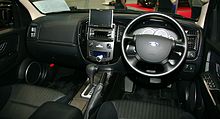
_XLS_wagon_(2011-04-22)_01.jpg)
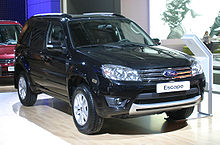
_wagon_(2010-09-23).jpg)
_wagon_(2010-07-05).jpg)
.jpg)

_V6_wagon_(2010-09-19).jpg)
